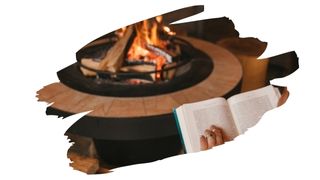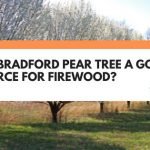If you want good clean burning firewood for your fireplace, then it needs to meet a few key criteria.
Criteria such as wood density, moisture content, and even that wood’s sap content. But, there’s one criteria that matters the most above them all — and that is the toxicity of that wood species.
Which begs the question; why would anyone risk burning wood from the Hemlock tree?
Well, in this post, you will discover what makes for clean burning firewood. You will also learn what separates Hemlock trees from their Poison-hemlock namesake.
And keep reading to find out how much energy Hemlock firewood can produce…

This post may contain affiliate links to products that we receive a commission for (at no additional cost to you). Learn more here.
What Type Of Wood Burns The Cleanest?
Clean burning firewood needs to be free of moisture.
You see, it is the moisture inside firewood that causes it to give off thick lung-clogging smoke. So, the less moisture it contains, then the cleaner it will burn.
Which means that firewood needs to be well-seasoned, (i.e. very dry), and free of sap or pitch.
Tree sap/pitch are resins that tree’s produce to protect themselves from bugs and harm. But, those tree resins can sometimes be watery enough to thicken up smoke as well.
So Wood Needs To Be Dry And Free Of Sap. Which Ones Do You Recommend?
The best types of firewood tend to be high-density hardwoods such as White Oak and Birch.
These two clean burning timbers don’t contain a lot of sap, (unlike say Pine or Cedar). And they are dense enough that they will burn hot for a good while to boot.
But, most importantly, neither one of these wood types come from a tree species that contains poisonous sap or toxic compounds.
Related Post: Are Heat Treated Pallets Safe To Burn As Firewood?
Should I Really Be Concerned About That? Won’t Burning Wood Get Rid Of Toxins?
No it won’t. In fact, burning wood from poisonous trees simply allows those toxins to gather in the soot.
Or worse, they can float around on the fumes and smoke released by burning these trees. And that is terrible news when it comes to your homes indoor air quality.
Related Post: Can You Safely Burn Camphor Wood In A Fireplace?
What About Hemlock Wood? Is It A Poisonous Tree?
Hemlock wood from the Hemlock tree is not poisonous. Far from it. This tree comes from the same tree family as Pine trees, and it is safe to burn.
You see, Hemlock Trees, (whose official name is ‘Tsuga heterophylla’), are a softwood lumber. And they bear no relation to the dangerous Poison-hemlock (a.k.a ‘Conium maculatum’).
Wait…Aren’t Hemlock Trees The Same As Poison Hemlock?
Nope, they are not. They are completely separate from each other.
Hemlock trees got their name due to the smell of its needles. When you crush the needles of the Hemlock tree, their scent bares a similarity to the scent of Poison-hemlock.
Nevertheless, Hemlock tree lumber does not contain any poisonous compounds. On the other hand, every part of the Poison-hemlock plant is incredibly toxic.
But Doesn’t Hemlock Wood Contain A Lot Of Sap (Like Pine Does)?
Not if you season it well. Seasoning simply refers to air-drying wood for a few months. And, the aim of seasoning, is to try and reduce the moisture content of wood.
Moisture content refers to the amount of water contained in firewood. When wood is freshly logged, it has a moisture content of nearly 100%. However, after wood has been seasoned, that moisture content falls to below 19%.
And, in the case of wood that has been kiln dried, wood’s moisture content can fall to as low as 12%.
So How Long Does It Take To Season A Stack Of Hemlock Firewood?
Typically, this takes around 6-12 months (depending on your local climate).
But, you’ll need to season Hemlock wood longer than most other types of firewood. Particularly as you’ll want to dry out the tree sap in it.
You can learn more about seasoning wood by checking out our post here: How To Season Wood (7 Tips)
That Means That Hemlock Wood Makes For Great Firewood?
Well, it means that you can safely burn Hemlock wood. It does not, however, make it the best option for firewood in general.
That is because Hemlock tree lumber is not that dense. So, there isn’t enough substance to it to allow it to burn for very long. And this is reflected in Hemlock woods BTU rating.
The BTU (British Thermal Unit) rating measures how much energy it takes to burn up firewood. The higher the rating, the more energy it takes to burn wood.
And the more energy it takes, the longer wood will burn — producing more heat for your home.
White Oak has a house-heating-high rating of 25.7 BTU. And Birch wood is not too far behind either, with it’s rating of 23.6 BTU.
But, Hemlock wood is way behind either one of them, with its rating of just 19.3 BTU.
This isn’t quite low enough to dismiss Hemlock wood as kindling. However, it’ll hardly produce a long-burning flame either.
To Wrap Up, Here Are The 3 Key Takeaways From This Post…
- 1). Hemlock wood comes from the Hemlock tree (Tsuga heterophylla).
- 2). Hemlock trees are a softwood, and they belong to the same tree family as Pine wood. Hemlock wood bares no relation to Poison-hemlock (Conium maculatum).
- 3). You can safely burn Hemlock tree firewood in a fireplace. But, it does not produce as much heat as hardwoods like White Oak and Birch.
References:
Wood Heating | Forestry.usu.edu
British Thermal Unit | Wikipedia.org



